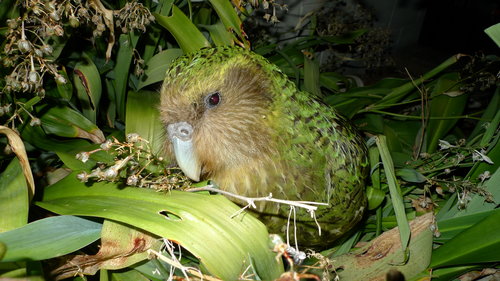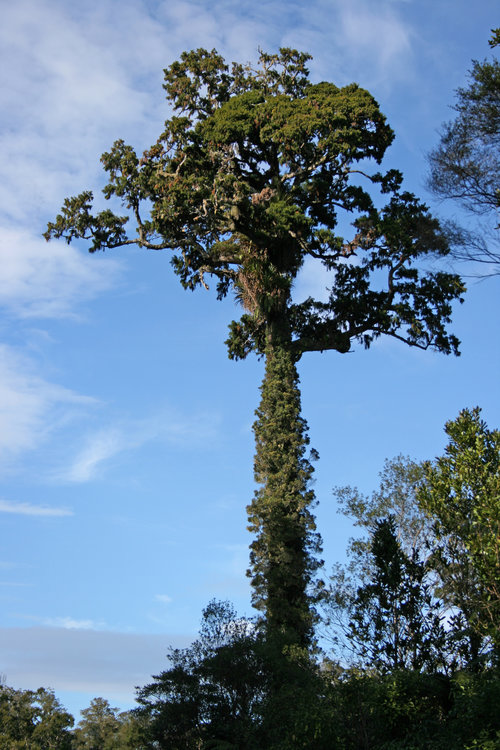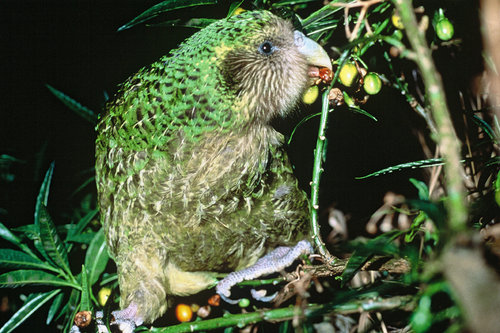#captive breeding

The plight of the kākāpō is a tragedy. Once the third most common bird in New Zealand, this large, flightless parrot has seen its numbers reduced to less than 150. In fact, for a time, it was even thought to be extinct. Today, serious effort has been put forth to try and recover this species from the brink of extinction. It has long been recognized that kākāpō breeding efforts are conspicuously tied to the phenology of certain trees but recent research suggests one in particular may hold the key to survival of the species.
The kākāpō shares its island homes (saving the kākāpō involved moving birds to rat-free islands) with a handful of tropical conifers from the families Podocarpaceae and Araucariaceae. Of these tropical conifers, one species is of particular interest to those concerned with kākāpō breeding - the rimu. Known to science as Dacrydium cupressinum, this evergreen tree represents one of the most important food sources for breeding kākāpō. Before we get to that, however, it is worth getting to know the rimu a bit better.


Rimu are remarkable, albeit slow-growing trees. They are endemic to New Zealand where they make up a considerable portion of the forest canopy. Like many slow-growing species, rimu can live for quite a long time. Before commercial logging moved in, trees of 800 to 900 years of age were not unheard of. Also, they can reach immense sizes. Historical accounts speak of trees that reached 200 ft. (61 m) in height. Today you are more likely to encounter trees in the 60 to 100 ft. (20 to 35 m) range.
The rimu is a dioecious tree, meaning individuals are either male or female. Rimu rely on wind for pollination and female cones can take upwards of 15 months to fully mature following pollination. The rimu is yet another one of those conifers that has converged on fruit-like structures for seed dispersal. As the female cones mature, the scales gradually begin to swell and turn red. Once fully ripened, the fleshy red “fruit” displays one or two black seeds at the tip. Its these “fruits” that have kākāpō researchers so excited.

As mentioned, it is a common observation that kākāpō only tend to breed when trees like the rimu experience reproductive booms. The “fruits” and seeds they produce are an important component of the diets of not only female kākāpō but their developing chicks as well. Because kākāpō are critically endangered, captive breeding is one of the main ways in which conservationists are supplementing numbers in the wild. The problem with breeding kakapo in captivity is that supplemental food doesn’t seem to bring them into proper breeding condition. This is where the rimu “fruits” come in.
Breeding birds desperately need calcium and vitamin D for proper egg production. As such, they seek out diets high in these nutrients. When researchers took a closer look at the “fruits” of the rimu, the kākāpō’s reliance on these trees made a whole lot more sense. It turns out, those fleshy scales surrounding rimu seeds are exceptionally high in not only calcium, but various forms of vitamin D once thought to be produced by animals alone. The nutritional quality of these “fruits” provides a wonderful explanation for why kākāpō reproduction seems to be tied to rimu reproduction. Females can gorge themselves on the “fruits,” which brings them into breeding condition. They also go on to feed these “fruits” to their developing chicks. For a slow growing, flightless parrot, it seems that it only makes sense to breed when food is this food source is abundant.

Though far from a smoking gun, researchers believe that the rimu is the missing piece of the puzzle in captive kākāpō breeding. If these “fruits” really are the trigger needed to bring female kākāpō into good shape for breeding and raising chicks, this may make breeding kākāpō in captivity that much easier. Captive breeding is the key to the long term survival of these odd yet charismatic, flightless parrots. By ensuring the production and survival of future generations of kākāpō, conservationists may be able to turn this tragedy into a real success story. What’s more, this research underscores the importance of understanding the ecology of the organisms we are desperately trying to save.
There is a rat nailed to my wall
Whilst I was stuffing a rat to look very alike to the pink rat to go on my spot pieces, I stopped and held the rat to the wall. I was holding the rat by its scruff, as it’s mother would carry it and it’s half stuffed body fell in line. I imagined the harshness of a nail holding it there against its will and thought artists should follow their instincts, so why not!
To me at the moment, this piece speaks a lot about cruelty. As an outsider taking a first glance at this piece you would be shocked and horrified, unknowing that this is a preserved rat. But does that change anything?
Since I made my first cut in taxidermy I have felt a lot of respect for the animal. Rats are often a symbol of disease, hatred and disgust, but I have always felt the need to do a good job in order to not disrespect the animals body. I feel like this piece does quite the opposite. I have spent hours removing, washing, preserving and filling its skin to make it immortal, only to viciously nail it to my wall in a mockery of its inability to refuse.
Okay so I feel pretty bad right now but I feel that I have created a symbol. Despite the disrespect I have show this rat, I have also given it a power to influence.
In some sense I believe this piece could be looked at as religious. The dyed fur of the rat ups it’s status to something better than an ordinary rat, it is humanised, special, beautiful and possibly intelligent and you as a viewer feel more inclined to feel sorry for it because of this. That great big nail in it comes with a hole lot of meaning, ‘crucifying’ the rat to the wall.
I feel like this piece speaks a lot about human nature and our strong belief in our intelligence, over our unquestioned ruling and our confidence in ourselves as the top of the food chain. We are bully’s not only to the rest of the natural world but to each other and we are selfish. The origins of this rat body are a prime example of this. Rats are bred in captivity in order to feed pet snakes, and in the same way as I held the rat to the wall by its scruff as it’s mother would, the rats are cared for and nurtured then mindlessly and without love, murdered for the sake of our pets. The control of an organism for personal gain is selfish and brings my point full circle.
I have disrespected this animals body for you to see and for you to understand. Maybe you will laugh at it, maybe you will cry but most likely you will be filled with a sad feeling that something is very wrong here.
Post link



